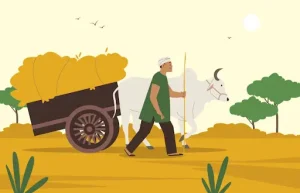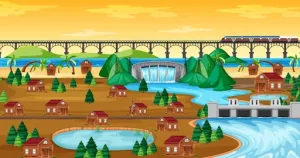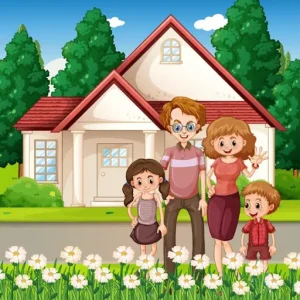No Place for Us – CBSE EVS Class 5 Explained with Fun Learning Tools
Welcome to iPrep, your Learning Super App.
Learn more about Chapter No Place for Us Class 5 Chapter 18 from the CBSE Environmental Studies textbook, to understand how migration affects families and communities. Using our learning resources for Class 5th ensures your understanding of this concept is clear and complete. Learn by watching animated videos, answering practice questions, and taking notes with the best of integrated learning.
No Place for Us: Exploring Migration and Its Challenges
Meet Jatryabhai and His Family
It was evening in Mumbai. The sun was setting behind tall buildings, and the air smelled of smoke and fish. Jatryabhai sat silently near the door of their tiny hut, his daughter Jhimli by his side. Together, they waited for Sidya, his son, to return from work.
Life in Mumbai was hard.
- Jatrya spent his day fixing torn fishing nets for a few rupees.
- Sidya, still a child, worked at a fish factory at dawn, went to school after lunch, and collected empty bottles in the evening to earn a little more.
- Water wasn’t free. Even a bucket of clean water costs money.
They had come from a village far away. They had come with hope. But here in this noisy city, every day felt like a battle.
Memories of Khedi – A Village That Lived in His Heart
Sometimes, Jatrya closed his eyes and let his thoughts wander back to Khedi, their old village. He could almost hear the chirping of birds, the laughter of children, and the drums of festival nights.
In Khedi:
- Everyone knew each other. People helped one another, like a big family.
- Children learned by doing: making clay pots, dancing, climbing trees, and listening to stories under the moonlight.
- The rivers were clean, the forests were green, and there was peace in the air.
“In No Place for Us, life in Khedi wasn’t rich, but it was peaceful and beautiful.”

Life in the village was simple yet fulfilling.
Activity: Compare Life in Khedi and Mumbai
Draw two columns in your notebook and write down:
- What life was like in Khedi village.
- How was it different in Mumbai?
Questions to Discuss:
- Have you ever felt lonely in a crowded place, like Jatrya did in Mumbai? Why?
- Why do families like Jatrya’s move to big cities?
The Big Change: Building a Dam
One day, the people of Khedi heard shocking news, a dam was to be built on the river, and their village would soon be underwater.
- Government promises:
- Villagers would be given land, schools, electricity, and buses in a new location.
- Reality:
- Many families didn’t want to leave their ancestral land.
- Despite their protests, the dam was built, and they were forced to move.
This part of No Place for Us Class 5 EVS Chapter highlights how development projects can displace entire communities.

Building dams often displaces many families.
Activity: Imagine the Challenges – No Place for Us
- Think about the problems families face when they are displaced.
- Draw a picture of Jatrya’s old village and compare it with his new village.
The Struggles in Sinduri Village
Jatrya’s family moved to Sinduri, but life was far from the dream they were promised:
- Living conditions: They lived in a one-room tin shed that was hot like an oven in summer.
- Farming challenges: The land was rocky and unsuitable for farming.
- Community differences: The people in Sinduri treated Jatrya’s family like “unwanted guests.”
Even necessities like water, electricity, and health services were difficult to access.
Finally Moving to Mumbai
After years of trying, Jatrya made a difficult decision. He sold his land in Sinduri and moved to Mumbai.
- His dream was to send his children to school and give them a better future.
- However, Mumbai posed its challenges:
- Overcrowded slums.
- Surrounded by noise and dust
- Struggles to save money for repairs and daily needs.
Jatrya wondered, “Will there ever be a place where we truly belong?”
👨👧👦 Jatrya’s Life in Mumbai – A Daily Struggle
In No Place for Us, we follow Jatrya and his children as they adjust to life in a crowded slum in Mumbai. Their home is a tiny hut surrounded by noise, smoke, and hardship.
- Jatrya spends his day repairing torn fishing nets for a small income.
- His young son, Sidya, wakes up early to work in a fish factory before going to school.
- In the evening, Sidya collects empty bottles to earn a little extra money.
- Even essential needs like water come at a cost—nothing is free in the city.
This part of the No Place for Us chapter highlights how difficult city life can be for families who migrate with dreams of a better future, only to face more challenges and disappointment.
Understanding Migration: Why Do People Move?
In the chapter No Place for Us, we learn that migration isn’t just about moving—it’s about leaving behind homes, memories, and sometimes even identities. People like Jatrya and his family didn’t move by choice, but were forced to leave their village due to dam construction.
People move because:
- They are poor and need work.
- Natural disasters destroy their homes.
- Big projects (like dams or factories) force them out.
- They want to give their children a better chance
Think and Reflect
- Have you seen families in your town who have moved from other places?
- How do they feel about their new home? Do they miss their old one?
What We Can Learn from Chapter No Place for Us.
The chapter No Place for Us Class 5 EVS teaches us valuable life lessons beyond just understanding migration:
- Everyone Deserves Respect: Migrant families often face discrimination and feel unwelcome in new places. Just like Jatrya’s family, many people leave behind everything familiar. It’s important that we treat everyone with kindness, no matter where they come from.
- Growth Must Be Fair: Development projects like dams may bring progress for some, but they can also force others to lose their homes and way of life. This lesson in No Place for Us reminds us that growth must include everyone.
- The Power of Community: In Khedi, life was full of support and togetherness. The chapter shows us how strong communities can make life better for everyone, especially for those who are struggling to rebuild after being displaced.
Final Activities from Chapter – No Place for Us
My Dream Home 🏡

Imagine you could design a new village for families like Jatrya’s. Think about:
- What kind of houses would they need in Chapter no place for us class?
- How would you provide water, electricity, and schools?
Draw your dream village and explain your design to your classmates!
To read the NCERT text of No Place for Us Class 5 EVS, click here.
To read our notes for the previous chapter Across the Wall, click here.
Practice questions on No Place for Us
Get your free No Place for Us practice quiz of 20+ questions & detailed solutions
Practice Now








